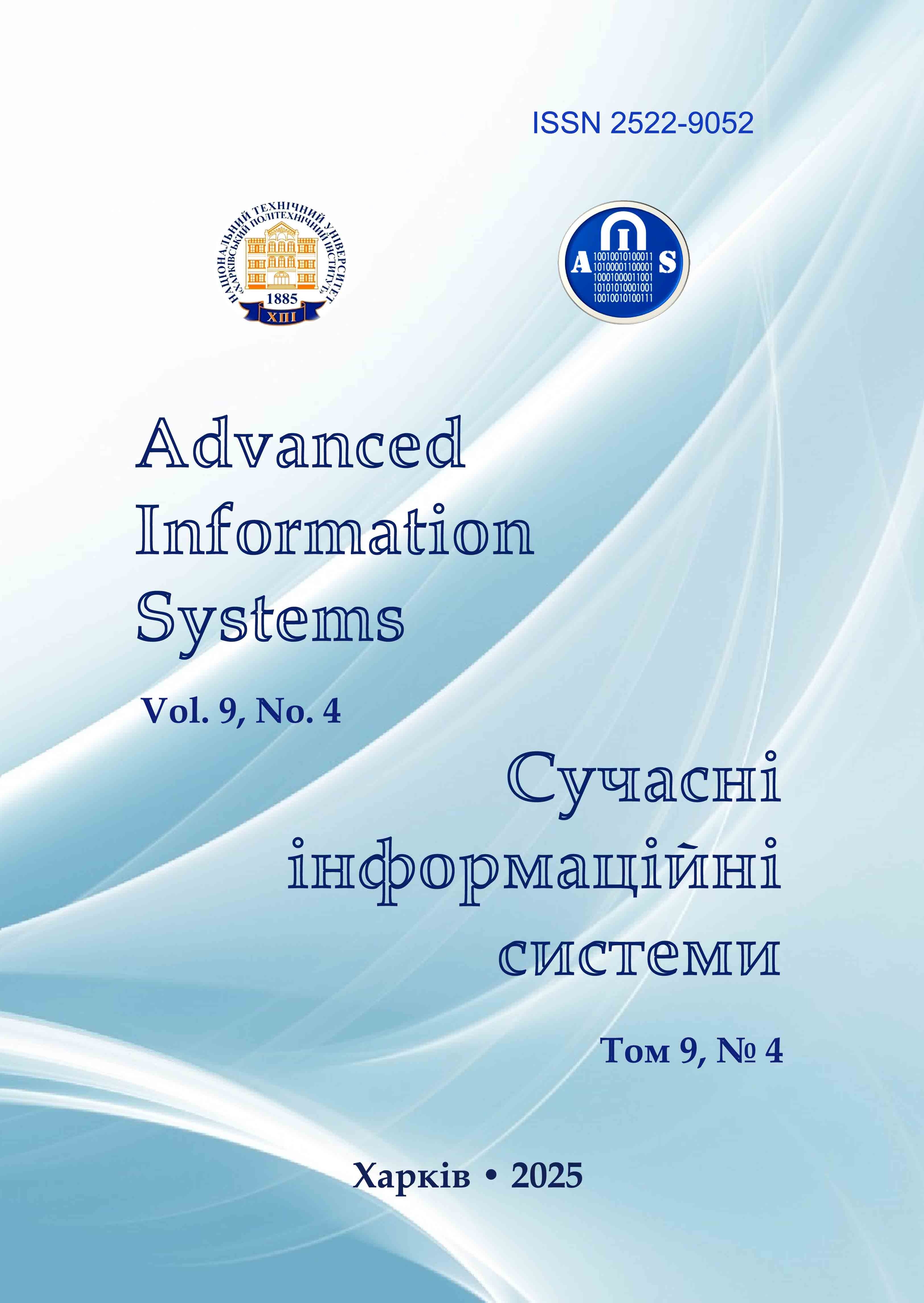A MULTI-TASK NEURAL NETWORK FOR SIMULTANEOUS REGRESSION AND CLASSIFICATION OF REGIONAL SECURITY AND QUALITY OF LIFE INDICES IN UKRAINE
Main Article Content
Abstract
In the face of contemporary geopolitical challenges and transformative processes, particularly the decentralization reform, the objective assessment and forecasting of regional stability have become critical tasks for ensuring Ukraine's sustainable development. This research addresses the lack of comprehensive, automated tools for analyzing the condition of territorial communities by developing and validating an innovative model based on artificial intelligence. The methodological foundation of this work is the development and testing of a multi-task deep learning neural network designed to simultaneously solve four related tasks. The model concurrently performs two regression tasks to predict the precise numerical values of the Regional Security Index (RSI) and the Quality of Life Index (LI), as well as two classification tasks to determine the categorical levels of these indices (low, medium, high). The theoretical basis for the formation of these target indices is the Quadruple Helix concept, which describes the synergistic interaction between government, business, the scientific community, and civil society. The model was trained on a unique dataset covering 1469 Ukrainian territorial communities and containing heterogeneous socio-economic and security indicators. The experimental results demonstrated the high efficiency of the developed approach. On the test set, the classification accuracy reached 93.9% for the Regional Security Index and 85.0% for the Quality of Life Index. In the regression tasks, the model showed low mean absolute error values, indicating high predictive accuracy for both categorical levels and specific index values. The study concludes that the created model is a powerful and effective tool for monitoring, analyzing, and forecasting the dynamics of regional development in Ukraine. The results can be used by state and local government bodies to develop targeted policies aimed at enhancing the resilience, cohesion, and attractiveness of Ukrainian regions.
Article Details
References
Kośmider, T. (2023), “National security and social capacity”, International Journal of Legal Studies, vol. 15 (1), pp. 11–19, doi: https://doi.org/10.5604/01.3001.0054.2801
Organisation for Economic Co-operation and Development (OECD), (2018), Maintaining the momentum of decentralisation in Ukraine. OECD Multi-level Governance Studies. OECD Publishing, doi: https://doi.org/10.1787/9789264301436-en
König, J., Suwala, L. and Delargy, C. (2020), “Helix models of innovation and Sustainable Development Goals”, Industry, innovation and infrastructure, Encyclopedia of the UN Sustainable Development Goals, pp. 1–15, Springer, Cham, doi: https://doi.org/10.1007/978-3-319-71059-4_91-1
Carayannis, E. and Campbell, D. (2009), “Mode 3’ and ‘Quadruple Helix’: Toward a 21st century fractal innovation ecosystem”, International Journal of Technology Management, vol. 46(3–4), pp. 201–234, doi: https://doi.org/10.1504/IJTM.2009.023374
evseiev, S., Ryabukha, Y., Milov, O., Milevskyi, S., Pohasii, S., Melenti, Y., Ivanchenko, Y., Ivanchenko, I., Opirskyy, I., and Pasko, I. (2021), “Development of a method for assessing forecast of social impact in regional communities”, Eastern-European Journal of Enterprise Technologies, vol. 6(2(114)), pp. 30–43, doi: https://doi.org/10.15587/1729-4061.2021.249313
Mozhaev, O., Kuchuk, H., Kuchuk, N., Mykhailo, M. and Lohvynenko, M. (2017), “Multiservice network security metric”, 2nd International Conference on Advanced Information and Communication Technologies, AICT 2017 – Proceedings, pp. 133–136, doi: https://doi.org/10.1109/AIACT.2017.8020083
Lashyn, Y., Trofymchuk, O., Zabolotnyi, S., Voitko, O. and Seabra, E. (2025), “Sentiment analysis of texts using recurrent neural networks of the transformer architecture”, Advanced Information Systems, vol. 9, no. 3, pp. 91–101, doi: https://doi.org/10.20998/2522-9052.2025.3.11
Kuchuk, N., Mozhaiev, O., Mozhaiev, M. and Kuchuk, H. (2017), “Method for calculating of R-learning traffic peakedness”, 2017 4th International Scientific-Practical Conference Problems of Infocommunications Science and Technology, PIC S and T 2017 – Proceedings, pp. 359–362, doi: https://doi.org/10.1109/INFOCOMMST.2017.8246416
Xu, Z., Liu, Z. and Luo, H. (2025), “Can artificial intelligence technology help achieving good governance: A public policy evaluation method based on artificial neural network, SAGE Open, vol. 15(1), doi: https://doi.org/10.1177/21582440251317833
Chen, X.-S., Kim, M., Lin, C.-H. and Na, H. (2025), “Development of per capita GDP forecasting model using deep learning: Including consumer goods index and unemployment rate”, Sustainability, vol. 17(3), article number 843, doi: https://doi.org/10.3390/su17030843
Khachiyan, A., Thomas, A., Zhou, H., Hanson, G., Cloninger, A., Rosing, T. and Khandelwal, A. (2022), “Using neural networks to predict microspatial economic growth”, American Economic Review: Insights, vol. 4(4), pp. 491–506, doi: https://doi.org/10.1257/aeri.20210422
Perry, C. (2013), “Machine learning and conflict prediction: A use case”, Stability: International Journal of Security & Development, vol. 2(3), art. 56, pp. 1–18, doi: https://doi.org/10.5334/sta.cr
Murphy, M., Sharpe, E. and Huang, K. (2024), “The promise of machine learning in violent conflict forecasting Data & Policy”, 6, e27, doi: https://doi.org/10.1017/dap.2024.27
Shaukat, K., Luo, S., Varadharajan, V., Hameed, I. and Xu, M. (2020), “A survey on machine learning techniques for cyber security in the last decade”, IEEE Access, vol. 8, pp. 222310–222354, doi https://doi.org/10.1109/ACCESS.2020.3041951
Ruder, S. (2017), “An overview of multi-task learning in deep neural networks”, arXiv: Computer Science, preprint arXiv:1706.05098, doi: https://arxiv.org/abs/1706.05098
Zhang, Y., & Yang, Q. (2017), “A survey on multi-task learning. IEEE Transactions on Knowledge and Data Engineering”, arXiv: Computer Science, preprint arXiv:1707.08114, doi: https://doi.org/10.48550/arXiv.1707.08114
Etzkowitz, H. (2008), The Triple Helix: University–industry–government innovation in action, Routledge, New York, doi: https://doi.org/10.4324/9780203929605
Martinez, G. and Pérez, L. (2022), “The Triple Helix and its intervention in the research and development of products for international security and defense”, Revista de Relaciones Internacionales, Estrategia y Seguridad, vol. 17, no. 1, pp. 31–46, doi: https://doi.org/10.18359/ries.5600
Schebesch, K., Șoim, H. and Blaga, R. (2024), “The triple-helix model as foundation of innovative entrepreneurial ecosystems”, Journal of Ethics in Entrepreneurship and Technology, vol. 4(1), doi: https://doi.org/10.1108/JEET-08-2024-0026
Gatune, J. (2023), “Triple helix as model for driving innovation in emerging economies – What it takes”, Sustainable development, 13, pp. 1–16, doi: https://doi.org/10.1515/9783111071251-014
Yang, Y. and Holgaard, J. (2012), “The important role of civil society groups in eco-innovation: A Triple Helix perspective”, Journal of Knowledge-based Innovation in China, vol. 4(2), pp. 132–148, doi: https://doi.org/10.1108/17561411211235730
Hladchenko, M. and Pinheiro, R. (2019), “Implementing the Triple Helix model: Means–ends decoupling at the state level?”, Minerva, vol. 57 (1), pp. 1–22, doi: https://doi.org/10.1007/s11024-018-9355-3
